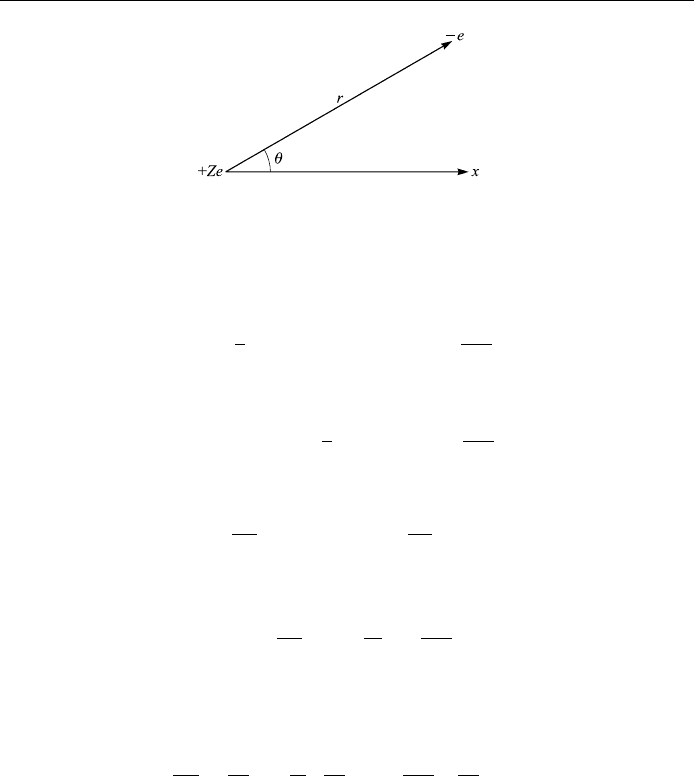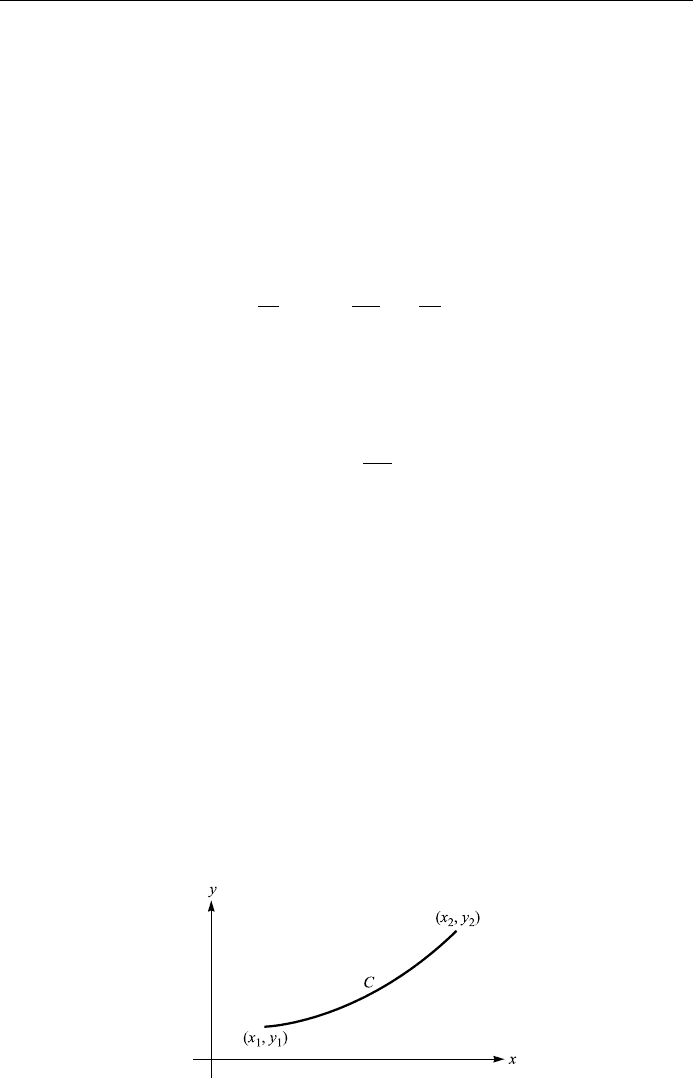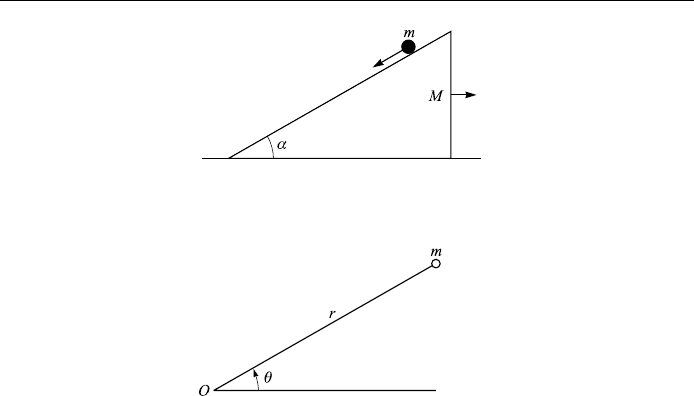Chow T.L. Mathematical Methods for Physicists: A Concise Introduction
Подождите немного. Документ загружается.


The action I may similarly be regarded as an explicit function of time, by
considering paths starting from a given point q
i
1 at a given instant t
1
, ending
at a given point q
i
2 at various times t
2
t:
I Iq
i
; t:
Then the total time derivative of I is
dI
dt
@I
@t
X
i
@I
@q
i
_
q
i
@I
@t
X
i
p
i
_
q
i
: 8:34
From the de®nition of the action, we have dI=dt L. Substituting this into Eq.
(8.34), we obtain
@I
@t
L ÿ
X
i
p
i
_
q
i
ÿH
or
@I
@t
Hq
i
; p
i
; t0: 8:35
Replacing the momenta p
i
in the Hamiltonian H by @I=@q
i
as given by Eq. (8.33),
we obtain the Hamilton±Jacobi equation
Hq
i
;@I=@q
i
; t
@I
@t
0: 8:36
For a conservative system with stationary constraints, the time is not contained
explicitly in Hamiltonian H,andH E (the total energy of the system).
Consequently, according to Eq. (8.35), the dependence of action I on time t is
expressed by the term ÿEt. Therefore, the action breaks up into two terms, one of
which depends only on q
i
, and the other only on t:
Iq
i
; tI
o
q
i
ÿEt: 8:37
The function I
o
q
i
is sometimes called the contracted action, and the Hamilton±
Jacobi equation (8.36) reduces to
Hq
i
;@I
o
=@q
i
E: 8:38
Example 8.8
To illustrate the method of Hamilton±Jacobi, let us consider the motion of an
electron of charge ÿe revolv ing about an atomic nucleus of charge Ze (Fig. 8.7).
As the mass M of the nucleus is much greater than the mass m of the electron, we
may consider the nucleus to remain stationary without making any very appreci-
able error. This is a cen tral force motion and so its motion lies entirely in one
plane (see Classical Mechanics, by Tai L. Chow, John Wiley, 1995). Employing
366
THE CALCULUS OF VARIATIONS

polar coordinates r and in the plane of motion to specify the position of the
electron relative to the nucleus, the kinetic and potential energies are, respectively,
T
1
2
m
_
r
2
r
2
_
2
; V ÿ
Ze
2
r
:
Then
L T ÿ V
1
2
m
_
r
2
r
2
_
2
Ze
2
r
and
p
r
@L
@
_
r
m
_
rp
p
@L
@
_
mr
2
_
:
The Hamiltonian H is
H
1
2m
p
2
r
p
2
r
2
ü!
ÿ
Ze
2
r
:
Replacing p
r
and p
in the Hamiltonian by @I=@r and @I=@, respectively, we
obtain, by Eq. (8.3 6), the Hamilton±Jacobi equation
1
2m
@I
@r
2
1
r
2
@I
@
2
"#
ÿ
Ze
2
r
@I
@t
0:
Variational problems with several independent variables
The functional f in Eq. (8.1) contains only one independent variable, but very
often f may contain several independent variables. Let us now extend the theory
to this case of several independent variables:
I
ZZZ
V
f fu; u
x
; u
y
; u
z
; x; y; zdxdydz ; 8:39
where V is assumed to be a bounded volume in space with prescribed values of
ux; y; z at its boundary S; u
x
@u=@x, and so on. Now, the variational problem
367
VARIATIONAL PROBLEMS
Figure 8.7.

is to ®nd the function ux; y; z for which I is stationary with respect to small
changes in the functional form ux; y; z.
Generalizing Eq. (8.2), we now let
ux; y; z;"ux; y; z; 0"x; y; z; 8:40
where x; y; z is an arbitrary well-behaved (that is, diÿerentiable) function which
vanishes at the boundary S. Then we have, from Eq. (8.40),
u
x
x; y; z;"u
x
x; y; z; 0"
x
;
and similar expressions for u
y
; u
z
;and
@I
@"
ý
ý
ý
ý
"0
ZZZ
V
@f
@u
@f
@u
x
x
@f
@u
y
y
@f
@u
z
z
dxdydz 0:
We next integrate each of the terms @f =@u
i
i
using `integration by parts' and the
integrated terms vanish at the boundary as required. After some simpli®cations,
we ®nally obtain
ZZZ
V
@f
@u
ÿ
@
@x
@f
@u
x
ÿ
@
@y
@f
@u
y
ÿ
@
@z
@f
@u
z
x ; y; zdxdydz 0:
Again, since x; y; z is arbitrary, the term in the braces may be set equal to zero,
and we obtain the Euler±Lagrange equation:
@f
@u
ÿ
@
@x
@f
@u
x
ÿ
@
@y
@f
@u
y
ÿ
@
@z
@f
@u
z
0: 8:41
Note that in Eq. (8.41) @=@x is a partial derivative, in that y and z are constant.
But @=@x is also a total derivative in that it acts on implicit x dependence and on
explicit x dependence:
@
@x
@f
@u
x
@
2
f
@x@u
x
@
2
f
@u@u
x
u
x
@
2
f
@u
2
x
@
2
f
@u
y
@u
x
u
xy
@
2
f
@u
z
@u
x
u
xz
: 8:42
Example 8.9
The Schro
È
dinger wave equation. The equations of motion of classical mechanics
are the Euler±Lagrange diÿerential equations of Hamilton's principle. Similarly,
the Schro
È
dinger equation, the basic equation of quantum mechanics, is also a
Euler±Lagrange diÿerential equation of a v ariational principle the form of which
is, in the case of a system of N particles, the following
Z
Ld 0; 8 :43
368
THE CALCULUS OF VARIATIONS

with
L
X
N
i1
p
2
2m
i
@ÿ*
@x
i
@ÿ
@x
i
@ÿ*
@y
i
@ÿ
@y
i
@ÿ*
@z
i
@ÿ
@z
i
Vÿ*ÿ 8:44
and the constraint
Z
ÿ*ÿd 1 ; 8:45
where m
i
is the mass of particle I, V is the potential energy of the system, and d is
a volume element of the 3N-dimensional space.
Condition (8.45) can be taken into consideration by introducing a Lagrangian
multiplier ÿE:
Z
L ÿ Eÿ*ÿd 0: 8:46
Performing the variation we obtain the Schro
È
dinger equation for a system of N
particles
X
N
i1
p
2
2m
i
r
2
i
ÿ E ÿ Vÿ 0; 8:47
where r
2
i
is the Laplace operator relating to particle i. Can you see that E is the
energy parameter of the system? If we use the Hamiltonian operator
^
H, Eq. (8.47)
can be written as
^
Hÿ Eÿ: 8:48
From this we obtain for E
E
Z
ÿ*Hÿd
Z
ÿ*ÿd
: 8:49
Through partial integration we obtain
Z
Ld
Z
ÿ*Hÿd
and thus the variational principle can be formulated in another way:
R
ÿ*H ÿ Eÿd 0.
Problems
8.1 As a simple practice of using varied paths and the extremum condition, we
consider the simple function yxx and the neighboring paths
369
PROBLEMS

y"; xx " sin x. Draw these paths in the xy plane between the limits
x 0andx 2 for " 0 for two diÿerent non-vanishing values of ". If the
integral I" is given by
I"
Z
2
0
dy=dx
2
dx;
show that the value of I" is always greater than I0, no matter what value
of " (positive or negative) is chosen. This is just condition (8.4).
8.2 (a) Show that the Euler±Lagrange equation can be written in the form
d
dx
f ÿ y
0
@f
@y
0
ÿ
@f
@x
0:
This is often called the second form of the Euler±Lagrange equation.
(b)Iff does not involve x explicitly, show that the Euler±Lagrange equation
can be integrated to yield
f ÿ y
0
@f
@y
0
c;
where c is an integration constant.
8.3 As shown in Fig. 8.8, a curve C joining points x
1
; y
1
and x
2
; y
2
is
revolved about the x-axis. Find the shape of the curve such that the surface
thus generated is a minimum.
8.4 A geodesic is a line that represents the shortest distance between two points.
Find the geodesic on the surface of a sphere.
8.5 Show that the geodesic on the surface of a right circular cylinder is a helix.
8.6 Find the shape of a heavy chain which minimizes the potential energy while
the length of the chain is constant.
8.7 A wedge of mass M and angle slides freely on a horizontal plane. A
particle of mass m moves freely on the wedge. Dete rmine the motion of
the particle as well as that of the wedge (Fig. 8.9).
370
THE CALCULUS OF VARIATIONS
Figure 8.8.

8.8 Use the Rayleigh±Ritz method to analyze the forced oscillations of a har-
monic oscillation:
m
x kx F
0
sin !t:
8.9 A particle of mass m is attracted to a ®xed point O by an inverse square
force F
r
ÿk=r
2
(Fig. 8.10). Find the canonical equations of motion.
8.10 Set up the Hamilton±Jacobi equation for the simple harmonic oscillator.
371
PROBLEMS
Figure 8.9.
Figure 8.10.

9
The Laplace transformation
The Laplace transformation method is generally useful for obtaining solutions of
linear diÿ erential equations (both ordinary and partial). It enables us to reduce a
diÿerential equation to an algebraic equation, thus avoiding going to the trouble
of ®nding the general solution and then evaluating the arbitrary constants. This
procedure or technique can be extended to systems of equations and to integral
equations, and it often yields results more readily than other techniques. In this
chapter we shall ®rst de®ne the Laplace transformation, then evaluate the trans-
formation for some elementary functions, and ®nally apply it to solve some simple
physical problems.
De®nition of the Lap ace transform
The Laplac e transform Lf x of a function f x is de®ned by the integral
Lf x
Z
1
0
e
ÿpx
f xdx Fp; 9:1
whenever this integral exists. The integral in Eq. (9.1) is a function of the para-
meter p and we denote it by Fp. The function Fp is called the Laplace trans-
form of f x. We may also look upon Eq. (9.1) as a de®nition of a Laplace
transform operator L which tranforms f x in to Fp. The operator L is linear,
since from Eq. (9.1) we have
Lc
1
f xc
2
gx
Z
1
0
e
ÿpx
fc
1
f xc
2
gxgdx
c
1
Z
1
0
e
ÿpx
f xdx c
2
Z
1
0
e
ÿpx
gxdx
c
1
Lf x c
2
Lgx;
372

where c
1
and c
2
are arbitrary constants and gx is an arbitrary function de®ned
for x > 0.
The inverse Laplace transform of Fp is a function f x such that
Lf x Fp. We denote the operati on of taking an inverse Laplace transform
by L
ÿ1
:
L
ÿ1
Fp f x: 9:2
That is, we operate algebraically with the operators L and L
ÿ1
, bringing them
from one side of an equation to the other side just as we would in writing ax b
implies x a
ÿ1
b. To illustrate the calculation of a Laplace transform, let us
consider the following simple example.
Example 9.1
Find Le
ax
, where a is a constant.
Solution: The transform is
Le
ax
Z
1
0
e
ÿpx
e
ax
dx
Z
1
0
e
ÿpÿax
dx:
For p a, the exponent on e is positive or zero and the integral diverges. For
p > a, the integral converges:
Le
ax
Z
1
0
e
ÿpx
e
ax
dx
Z
1
0
e
ÿpÿax
dx
e
ÿpÿax
ÿp ÿ a
ÿ
ÿ
ÿ
ÿ
1
0
1
p ÿ a
:
This example enables us to investigate the existence of Eq. (9.1) for a general
function f x.
Existence of Laplace transforms
We can prove that:
(1) if f x is piecewise continuous on every ®nite interval 0 x X, and
(2) if we can ®nd constants M and a such that jf xj Me
ax
for x X,
then Lf x exists for p > a. A function f x which satis®es condition (2) is said
to be of exponential order as x !1; this is mathematician's jargon!
These are sucient conditions on f x under which we can guarantee the
existence of Lf x. Under these conditions the integral converges for p > a:
Z
X
0
f xe
ÿpx
dx
ÿ
ÿ
ÿ
ÿ
ÿ
ÿ
ÿ
ÿ
Z
X
0
f x
jj
e
ÿpx
dx
Z
X
0
Me
ax
e
ÿpx
dx
M
Z
1
0
e
ÿpÿax
dx
M
p ÿ a
:
373
EXISTENCE OF LAPLACE TRANSFORMS

This establishes not only the convergence but the absolute convergence of the
integral de®ning Lf x. Note that M=p ÿ a tends to zero as p !1. This
shows that
lim
p!1
Fp0 9 :3
for all functions FpLf x such that f x satis®es the foregoi ng conditions
(1) and (2). It follows that if lim
p!1
Fp60, Fp cannot be the Laplace trans-
form of any function f x.
It is obvious that functions of exponential order play a dominant role in the use
of Laplace transforms. One simple way of determining whether or not a speci®ed
function is of exponential order is the following one: if a constant b exists such
that
lim
x!1
e
ÿbx
f x
jj
hi
9:4
exists, the function f x is of exponential order (of the order of e
ÿbx
. To see this,
let the value of the above limit be K 6 0. Then, when x is large enough, je
ÿbx
f xj
can be made as close to K as possible, so certainly
je
ÿbx
f xj < 2K:
Thus, for suciently large x,
jf xj < 2Ke
bx
or
jf xj < Me
bx
; with M 2K:
On the other hand, if
lim
x!1
e
ÿcx
f x
jj
1 9:5
for every ®xed c, the function f x is not of exponential order. To see this , let us
assume that b exists such that
jf xj < Me
bx
for x X
from which it follows that
je
ÿ2bx
f xj < Me
ÿbx
:
Then the choice of c 2b would give us je
ÿcx
f xj < Me
ÿbx
, and e
ÿcx
f x!0as
x !1which contradicts Eq. (9.5).
Example 9.2
Show that x
3
is of exponential order as x !1.
374
THE LAPLACE TRANSFORMATION

Solution: We have to check whether or not
lim
x!1
e
ÿbx
x
3
lim
x!1
x
3
e
bx
exists. Now if b > 0, then L'Hospital's rule gives
lim
x!1
e
ÿbx
x
3
lim
x!1
x
3
e
bx
lim
x!1
3x
2
be
bx
lim
x!1
6x
b
2
e
bx
lim
x!1
6
b
3
e
bx
0:
Therefore x
3
is of exponential order as x !1.
Laplace transforms of some elementary functions
Using the de®nition (9.1) we now obtain the transform s of polynomials, expo-
nential and trigonometric functions.
(1) f x1 for x > 0.
By de®nition, we have
L1
Z
1
0
e
ÿpx
dx
1
p
; p > 0:
(2) f xx
n
, where n is a positive integer.
By de®nition, we have
Lx
n
Z
1
0
e
ÿpx
x
n
dx:
Using integration by parts:
Z
uv
0
dx uv ÿ
Z
vu
0
dx
with
u x
n
; dv v
0
dx e
ÿpx
dx ÿ1=pde
ÿpx
; v ÿ1=pe
ÿpx
;
we obtain
Z
1
0
e
ÿpx
x
n
dx
ÿx
n
e
ÿpx
p
1
0
n
p
Z
1
0
e
ÿpx
x
nÿ1
dx:
For p > 0 and n > 0, the ®rst term on the right hand side of the above equation is
zero, and so we have
Z
1
0
e
ÿpx
x
n
dx
n
p
Z
1
0
e
ÿpx
x
nÿ1
dx
375
LAPLACE TRANSFORMS OF ELEMENTARY FUNCTIONS
